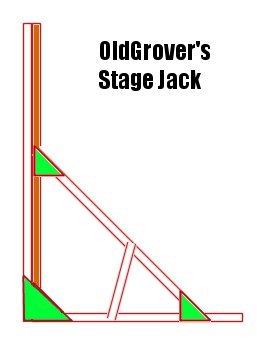The is similar to my platform question over in Carpentry - basically, I'm going to describe how I did something and invite comments and criticism. What I did WORKED, but I wasn't able to find a really good description of stage jacks on the internet... and my books are on order  (*grumbles* Local bookstores useless)
(*grumbles* Local bookstores useless)
Anyways, these were a combination of a request from the TD and my own thought pattern. Tools were a brad nailer firing 1 5/8ths inch 18 ga brads and glue, plus a miter saw, with the joints expected to be primarily held by the glue once it dries.
For a previous play, I built 4' stage jacks for the 8' flats (so, up to the toggle, though most of our flats are doublesided with 1/4th plywood, except the one I just built, which was done very much like ship's /long/ description in this forum, but faced with 1/4th luan mahogany instead of fabric). For this one, I was asked to build full 8' high jacks, so they could be screwed to the panels at top, toggle and bottom. Fair enough. Also, I was asked to make sure they would not flex vertically and the TD suggested the mechanism I ended up using.
So, to start, took 2 8' 1x4s, built an L out of them, with glue and brads. I cut the L at both ends to make the total slightly shy of 8' and to ensure a flush fit on the top and bottom (don't want the jack peeking over the flat if the guy who built the flat made it a little low). For the bottom piece, I cut a 1 x 4 to length (I did about 4 1/2 feet) and glued and stapled to the bottom of the vertical piece, flat to the floor. The side of the L obviously gave me more stapling and gluing room. Carpenter's square made sure it was level and a piece of plywood (was actually half inch, because that's what I had) in a triangle made it stay that way, glued and bradded. A small triangle on the other side added strength. That gave the bottom and the vertical, but I needed the diagonal to give it strength. I attached a 45 degree triangle (again half inch ply) on the horizontal, measured from there to where it intersected the vertical. Cut a piece of 1 x 4 to size, attached it to the triangle. With nailgun and level in hand, plumbed again the vertical and attached the diagonal to the brace. Another triangle braced that joint and yet another did the other side at the horizontal joint. Adding a probably extraneous brace from the diagonal down to the horizontal completed the job.
Picture :

I'm sure there were better ways to do this, but any comments on flaws in this mechanism? Every joint is glued and bradded (though as I say, the brads don't add /strength/, they just hold the joint flush until the glue dries.
(edited to fix the picture)
-OG
Anyways, these were a combination of a request from the TD and my own thought pattern. Tools were a brad nailer firing 1 5/8ths inch 18 ga brads and glue, plus a miter saw, with the joints expected to be primarily held by the glue once it dries.
For a previous play, I built 4' stage jacks for the 8' flats (so, up to the toggle, though most of our flats are doublesided with 1/4th plywood, except the one I just built, which was done very much like ship's /long/ description in this forum, but faced with 1/4th luan mahogany instead of fabric). For this one, I was asked to build full 8' high jacks, so they could be screwed to the panels at top, toggle and bottom. Fair enough. Also, I was asked to make sure they would not flex vertically and the TD suggested the mechanism I ended up using.
So, to start, took 2 8' 1x4s, built an L out of them, with glue and brads. I cut the L at both ends to make the total slightly shy of 8' and to ensure a flush fit on the top and bottom (don't want the jack peeking over the flat if the guy who built the flat made it a little low). For the bottom piece, I cut a 1 x 4 to length (I did about 4 1/2 feet) and glued and stapled to the bottom of the vertical piece, flat to the floor. The side of the L obviously gave me more stapling and gluing room. Carpenter's square made sure it was level and a piece of plywood (was actually half inch, because that's what I had) in a triangle made it stay that way, glued and bradded. A small triangle on the other side added strength. That gave the bottom and the vertical, but I needed the diagonal to give it strength. I attached a 45 degree triangle (again half inch ply) on the horizontal, measured from there to where it intersected the vertical. Cut a piece of 1 x 4 to size, attached it to the triangle. With nailgun and level in hand, plumbed again the vertical and attached the diagonal to the brace. Another triangle braced that joint and yet another did the other side at the horizontal joint. Adding a probably extraneous brace from the diagonal down to the horizontal completed the job.
Picture :

I'm sure there were better ways to do this, but any comments on flaws in this mechanism? Every joint is glued and bradded (though as I say, the brads don't add /strength/, they just hold the joint flush until the glue dries.
(edited to fix the picture)
-OG


